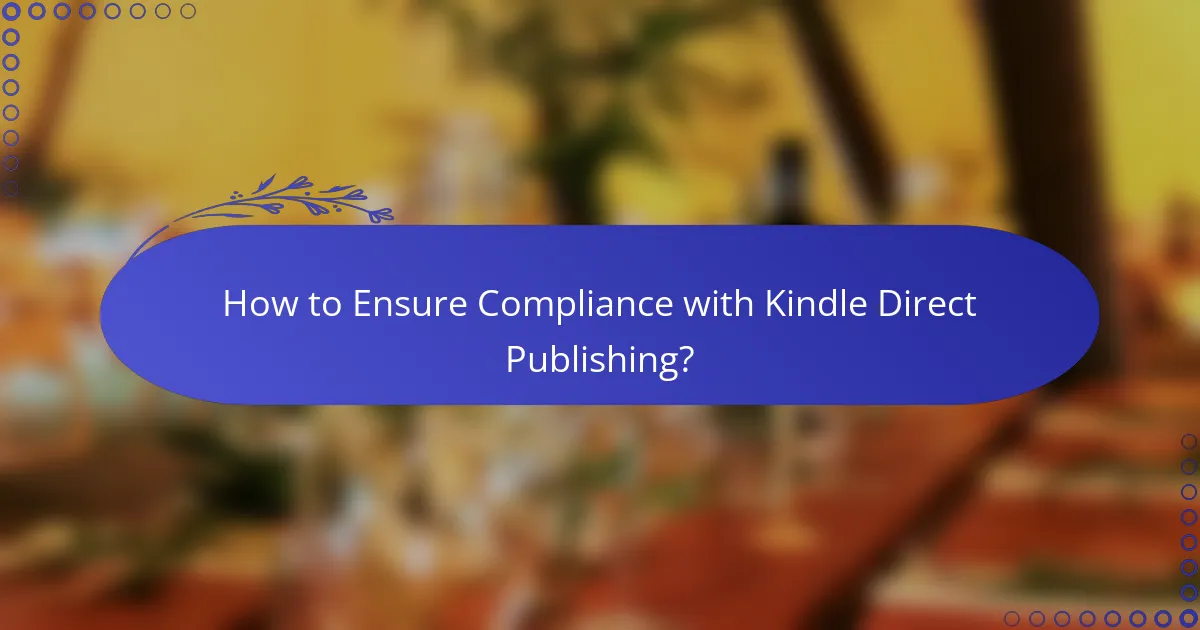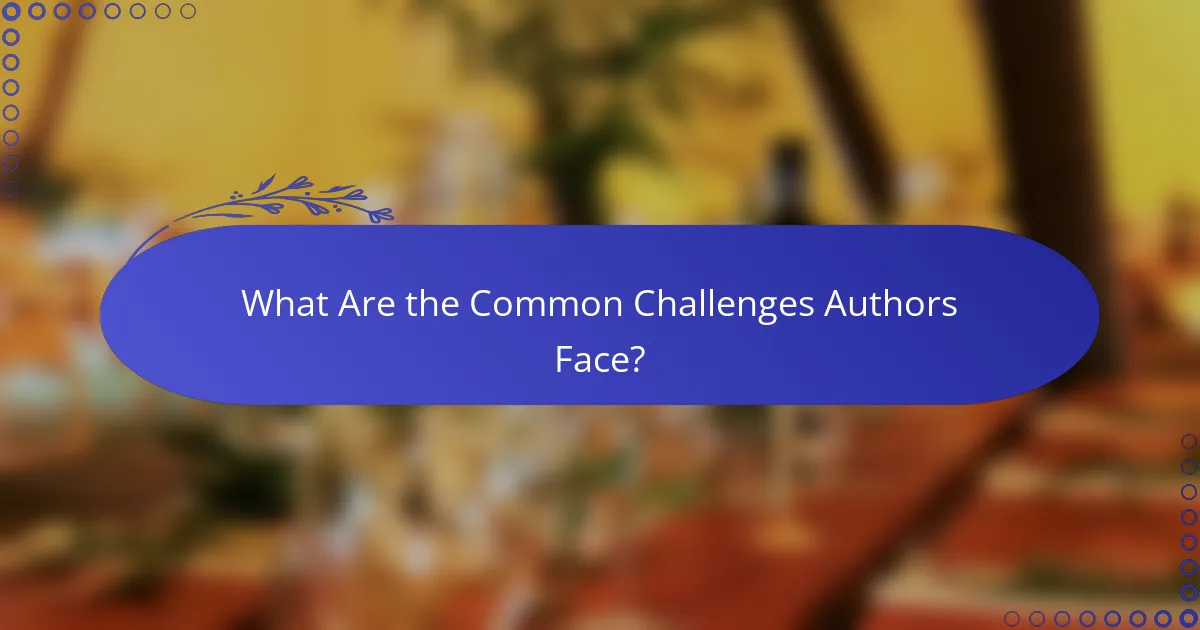Kindle Direct Publishing (KDP) provides authors with essential guidelines covering content formatting, cover design, and compliance with copyright and quality standards. By following these guidelines, authors can ensure their work meets Amazon’s requirements and effectively reaches their intended audience. Additionally, KDP offers a wealth of resources, including marketing tools and educational materials, to support authors throughout their publishing journey.

What Are the Key Guidelines for Kindle Direct Publishing?
The key guidelines for Kindle Direct Publishing (KDP) encompass content formatting, cover design, metadata, pricing, and the publication process. Adhering to these guidelines ensures your book meets Amazon’s standards and reaches your target audience effectively.
Content formatting requirements
Content formatting for KDP requires that your manuscript be in a compatible file format, such as .doc, .docx, or .epub. Ensure your text is properly structured with headings, paragraphs, and images formatted correctly to enhance readability on Kindle devices.
Use standard fonts like Times New Roman or Arial, and maintain a font size of at least 11 points. Avoid excessive formatting, such as multiple font styles or colors, as these can disrupt the reading experience.
Cover design specifications
Your book cover must be a high-resolution image, ideally 300 DPI, with dimensions of at least 2560 x 1600 pixels. The cover should be visually appealing and relevant to your book’s content, as it plays a crucial role in attracting readers.
Amazon recommends using a JPEG or TIFF format for the cover image. Ensure that the title and author name are clearly legible, and avoid cluttered designs that may confuse potential buyers.
Metadata guidelines
Metadata includes essential information about your book, such as the title, author name, description, keywords, and categories. Accurate metadata helps improve discoverability on Amazon’s platform.
Choose keywords that potential readers might use to search for your book, and select appropriate categories that reflect your genre. This will enhance your book’s visibility and increase the chances of sales.
Pricing and royalty structures
KDP offers two royalty options: 35% and 70%. The 70% royalty option is available for books priced between $2.99 and $9.99, while the 35% option applies to books outside this range. Consider your pricing strategy carefully to maximize earnings.
Keep in mind that Amazon deducts delivery costs for books sold under the 70% royalty option, which can affect your overall earnings. Regularly review your pricing to stay competitive within your genre.
Publication process overview
The publication process on KDP involves several steps: creating an account, uploading your manuscript and cover, entering metadata, and setting your pricing. After submission, Amazon will review your book for compliance with their guidelines.
Once approved, your book will be available for purchase on Amazon within a few hours to a couple of days. Monitor your sales and reviews to make adjustments to your marketing strategy as needed.

How to Ensure Compliance with Kindle Direct Publishing?
To ensure compliance with Kindle Direct Publishing (KDP), authors must adhere to specific guidelines regarding copyright, content quality, and prohibited content types. Understanding these requirements is crucial for a successful publishing experience on the platform.
Copyright and intellectual property standards
Authors must respect copyright laws and intellectual property rights when publishing on KDP. This includes ensuring that all content is original or properly licensed. Using public domain works or obtaining permission for copyrighted material is essential to avoid legal issues.
It is advisable to conduct thorough research on copyright status and to provide proper attribution where necessary. Familiarizing yourself with the U.S. Copyright Office guidelines can help clarify what is permissible.
Content quality expectations
KDP expects high-quality content that meets reader expectations. This includes well-edited manuscripts, professional formatting, and engaging cover designs. Authors should aim for a polished final product that enhances the reading experience.
Consider utilizing editing services or beta readers to improve your manuscript. Additionally, following KDP’s formatting guidelines can help ensure your book is presented professionally, which can lead to better reviews and sales.
Prohibited content types
KDP has strict rules regarding prohibited content types, which include hate speech, explicit adult content, and illegal activities. Content that promotes violence or discrimination is also not allowed. Violating these guidelines can result in account suspension or book removal.
Before publishing, review KDP’s content guidelines to ensure compliance. Avoid including any material that could be considered offensive or inappropriate to maintain a positive reputation and avoid penalties.

What Resources Are Available for Authors Using Kindle Direct Publishing?
Authors using Kindle Direct Publishing (KDP) have access to a variety of resources designed to support their publishing journey. These resources include forums for peer support, marketing tools to promote their work, and educational materials to enhance their publishing skills.
Author support forums
KDP offers author support forums where writers can connect, share experiences, and seek advice from fellow authors. These forums are a valuable space for discussing challenges, sharing success stories, and finding solutions to common issues faced during the publishing process.
Engaging in these forums can provide insights into best practices and help authors stay updated on KDP policies and features. It’s advisable to participate actively and contribute to discussions to build a network within the author community.
Marketing tools and strategies
KDP provides several marketing tools to help authors promote their books effectively. Authors can utilize promotional pricing, Kindle Countdown Deals, and Free Book Promotions to attract readers and boost visibility.
Additionally, authors should consider leveraging social media platforms, email newsletters, and book review sites to enhance their marketing strategies. A well-rounded approach can significantly increase a book’s reach and sales potential.
Publishing tutorials and webinars
KDP offers a range of publishing tutorials and webinars that guide authors through the self-publishing process. These resources cover essential topics such as formatting, cover design, and marketing techniques, helping authors navigate the complexities of publishing.
Participating in these tutorials can equip authors with the knowledge needed to make informed decisions. It’s beneficial to regularly check for new webinars and updates to stay current with KDP’s evolving features and best practices.

What Are the Common Challenges Authors Face?
Authors often encounter several challenges when using Kindle Direct Publishing (KDP), including formatting issues, marketing difficulties, and understanding royalties. Navigating these obstacles is crucial for successfully publishing and promoting a book.
Formatting issues
Formatting issues can significantly hinder the publishing process on KDP. Authors must ensure their manuscripts meet specific formatting guidelines, such as proper margins, font sizes, and file types. A common pitfall is neglecting to preview the book using KDP’s tools, which can lead to unexpected layout problems.
To avoid these issues, consider using KDP’s free formatting resources or templates. Familiarize yourself with the requirements for both eBooks and print books, as they differ. Double-check your document for consistency in headings, spacing, and image placement before submission.
Marketing difficulties
Marketing difficulties are prevalent among authors who may lack experience in promoting their work. Crafting an effective marketing strategy is essential for increasing visibility and sales. Many authors struggle with identifying their target audience and utilizing social media effectively.
To enhance marketing efforts, consider building an author platform through a website or blog. Engage with readers on social media and explore options like Amazon Advertising to reach a broader audience. Networking with other authors can also provide valuable insights and support.
Understanding royalties
Understanding royalties is crucial for authors to maximize their earnings on KDP. Authors typically earn royalties based on the price of their books and the distribution options they choose. KDP offers two royalty options: 35% and 70%, depending on factors like book pricing and geographic distribution.
To optimize royalties, authors should carefully consider their book pricing strategy. Pricing within the $2.99 to $9.99 range often allows for the 70% royalty option, while prices outside this range may only qualify for 35%. Regularly reviewing sales data can help authors adjust their pricing and maximize earnings over time.

How to Optimize Your Book for Kindle Direct Publishing?
To optimize your book for Kindle Direct Publishing (KDP), focus on keyword research, crafting compelling book descriptions, and utilizing Amazon ads effectively. These strategies enhance visibility and increase sales potential on the platform.
Keyword research techniques
Keyword research is essential for improving your book’s discoverability on KDP. Start by identifying relevant keywords that potential readers might use when searching for books in your genre. Tools like Amazon’s search bar suggestions and third-party keyword research tools can help you find popular terms.
Consider using a mix of broad and specific keywords. Broad keywords attract a wider audience, while specific keywords target niche readers. Aim for a balance that reflects your book’s content accurately.
Effective book descriptions
Your book description is a critical marketing tool on KDP. It should be engaging and informative, highlighting the main themes and unique selling points of your book. Use a hook in the first few lines to capture the reader’s attention immediately.
Incorporate relevant keywords naturally within the description to improve search visibility. Keep the tone consistent with your book’s genre and consider using bullet points for key features or benefits to enhance readability.
Leveraging Amazon ads
Amazon ads can significantly boost your book’s visibility and sales on KDP. Start by setting a budget and choosing the right ad type, such as Sponsored Products or Lockscreen Ads. Monitor your campaigns regularly to assess performance and make necessary adjustments.
Target specific keywords and categories that align with your book’s content. This targeted approach can help you reach the right audience. Additionally, consider running promotions or discounts alongside your ads to maximize their effectiveness.

What Are the Best Practices for Pricing Your Book?
Setting the right price for your book is crucial for maximizing sales and reaching your target audience. Consider factors such as genre, length, and market trends to determine an effective pricing strategy.
Understand Your Genre and Audience
Different genres have varying pricing norms. For example, romance novels often sell well at lower prices, while academic texts may command higher prices due to their specialized content. Research similar titles in your genre to gauge what readers are willing to pay.
Knowing your audience is essential. If your target readers are price-sensitive, consider pricing your book competitively to attract more buyers. Conversely, if your book offers unique value, you might justify a higher price.
Consider Book Length and Format
The length and format of your book can significantly influence its price. E-books typically range from $2.99 to $9.99, while print books may vary more widely based on production costs. For instance, a 300-page paperback might be priced between $14.99 and $19.99.
Additionally, consider offering different formats at varying price points. Bundling an e-book with a print version can entice readers to purchase both, often at a slight discount compared to buying them separately.
Utilize Promotional Pricing Strategies
Promotional pricing can be an effective way to boost visibility and sales. Consider launching your book at a lower introductory price to encourage early purchases and reviews. This strategy can help build momentum and attract more readers.
Additionally, consider periodic discounts or limited-time offers to create urgency. Tools like Kindle Countdown Deals can help you manage these promotions effectively while maintaining control over your pricing strategy.
Regularly Review and Adjust Your Pricing
Pricing is not a one-time decision. Regularly review your book’s performance and adjust the price accordingly. If sales are slow, consider lowering the price or running a promotion. Conversely, if your book gains traction, you might explore raising the price.
Keep an eye on market trends and competitor pricing as well. Staying informed allows you to remain competitive and responsive to changes in reader preferences and market conditions.
